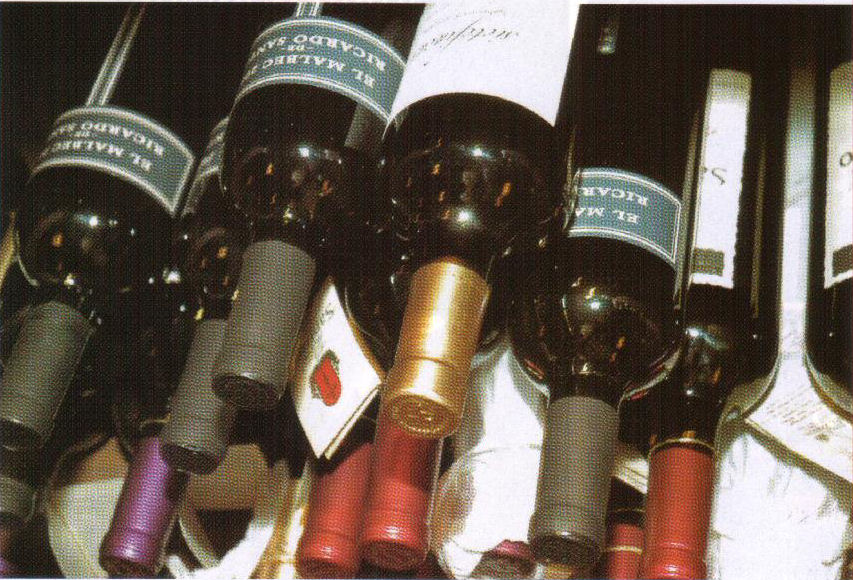Buenos Aires for Visitors
Winter/Spring 2007
Page 64
Dan Perlman finds a bottle for every budget
To some, it’s a ‘full-bodied explosion of currant fruit and notes of cocoa with subtle toasty oak and a long finish’. To others, ‘it’s just grape juice’. Forget politics or religion; a topic that truly polarizes the average dinner party crowd is wine, especially when the discussion turns into long-winded, pedantic arguments that inevitably end in the suggestion that the group orders a pricey bottle. And in most restaurants, a hundred dollars will get you some pretty amazing ‘grape juice’.
But, it’s not all about the money. For most of us its about the simple pleasure of enjoying a bottle of wine with friends, over a nice meal. Fortunately for connoisseurs and casual enthusiasts alike, Argentina produces a range of fine wines to suit all palates and budgets.
The good news for wine lovers of little means (or those who just don’t want to deal with pretentious sales staff in the city’s high-end wine shops) [Note: that parenthetical was added by my editor, who has a vastly different view of sommeliers and salespeople than I do.] is that you don’t need to go into a specialty store to pick up a drinkable bottle of red. Most basic grocery stores stock San Felipe ‘Doce Uvas’, a spicy, fruity blend of twelve different grapes that’ll cost you AR$8 in a shop and around AR$15 in a restaurant. Yup, we’re talking about the quirky, squat oval bottle on sale alongside shampoo and instant soup at your neighborhood supermarket.
In the same budget range, there’s an entire line of wines from a subsidiary of the well known Bodega Esmeralda, that are bottled with an eye towards emphasizing the pure flavors of individual grapes. There are a dozen of them, and so far all worth trying, but the current standout of the Rodas Colección 12 is their Petite Verdot, which will set you back about AR$8-9 in stores and around AR$15-18 in restaurants.
It’s a shame that these wines haven’t picked up more of a following in the restaurant world, because they’re amazingly food friendly – a line of Shiraz (or Syrah) blends coming from Bodegas Callia out of San Juan province – but if you see one, grab it. My personal favorite is the Callia Alta Shiraz-Tannat, a bold, spicy wine that’s a great steak complement – at AR$10-12 in stores and AR$18-20 in the few scattered dining spots that carry it, it’s a steal.
There’s a lot of competition in the next price range up, in fact, something around the AR$20-25 mark, or about AR$15-18 in stores. We’re partial to the Finca La Linda line, which isn’t obscure, but certainly isn’t one of the usual suspects, either. Their Tempranillo is particularly good.
For those who like to allocate more of their budget to wine, lay down AR$25-30 for a bottle of Sur de Los Andes Bonarda. While there’s as much of this grape planted in Argentina as there is Malbec, it’s not nearly as well known, but ought to be.
We haven’t recommended a Malbec yet. Where does the Argentinian classic fit in the budget list? It’s not that there aren’t good ones in the lower price ranges, but for our money, Malbec tends to shine when you hit the mid to higher range bottles. Our top pick in the next price range up is Malbec de Ricardo Santos, which costs about AR$35-40 in stores and AR$50-60 in a restaurant. It’s a beautifully structured unoaked Malbec, exactly what the grape is all about.
If your group appreciates the finer things but still wants to keep a bit of a rein on the budget, try a relatively new wine out of Salta, a blend of Malbec and Cabernet from high-altitude producer Raul Davidos. Bodega Tacuil “RD” is a true stunner, packed with fruit and amazingly balanced. Coming in at about AR$65 in stores and AR$80-90 in restaurants, the bottle can still be considered affordable.
One of the best known Argentinian wineries is Escorihuela Gascon. A couple of years ago they introduced a line of limited production wines, each of which is exceptional. Our personal favorite is the Escorihuela Gascon “Pequeños Producciones” Barbera, which will set you back AR$80-90 pesos in shops, and around AR$120 in restaurants.
Dig deep in your wallet: we’re heading upmarket towards some of the best bottles in Argentina, or indeed anywhere. The top-end wines – AR$100-500 in restaurants – just keep getting better and better. If you’re up for spending around AR$90 in the stores and AR$125 or so in restaurants, Trapiche Ciento Viente Años is a great blend of Malbec, Cabernet, and Petite Verdot.
The grand prize of Argentinian wine goes to a bottle that sings Malbec, San Pedro de Yacochuya, a wine from the Michel Rolland stable, which, depending on vintage, will set you back anywhere from AR$150-300 in stores and AR$250-500 at the table. If that works for your wallet and ‘grape juice’craving, you can’t do much better.
In mid-2006, I started writing for Time Out Buenos Aires. With changes in their way of conducting business, I decided to part company with them after my last article and set of reviews in mid-2009.
